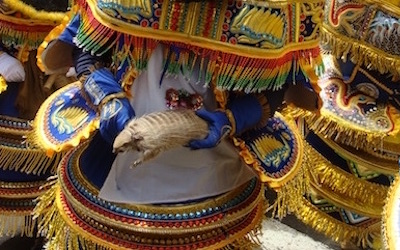The not so bright future of the Andean Hairy Armadillo?
By: Carmen Julia Quiroga, Affiliated Researcher, Museo de Historia Natural Alcide d’Orbigny
Attracting thousands of dancers and visitors, energetic bands and colourful costumes, every year the small Bolivian town of Oruro, hosts a UNESCO recognised Carnival, the Carnival of Oruro. While the party brings joy and a unique display of Andean culture, it is also a dark moment for the Andean hairy armadillo. Every year over 1,500 dancers use a music rattle as part of the costume, for which the main material is made from the Andean hairy armadillo. However, the production of this musical instrument is only one of the many cultural uses of the species across the Andes.
As part of my Master’s dissertation at DICE (Durrell Institute of Conservation and Ecology), I started research to better understand the utilisation and appreciation of the Andean hairy armadillo, thereby exploring the possibility to convert its cultural value into conservation impact. Urban areas of major Andean cities in Bolivia were chosen for data collection, making use of interviews, structured questionnaires, as well as visiting museums and local markets.
Results showed the Andean hairy armadillos to be sold and used as musical instruments, lucky charms, in traditional medicine and as pets. The legal framework in Bolivia is weak and ambiguous, as it the legislation relating to its trade – it is illegal to trade wildlife, unless for cultural uses. During Carnival alone, around 8000 pieces of wildlife are used in the costumes (armadillos, skins, feather and other parts). However, definitions and limitations of what is considered “cultural use” is non-existent. Few markets in the cities of Cochabamba and La Paz are controlled by municipal guards, and most merchants still offer dead armadillos on the side.
Analysing consumers’ responses to our questionnaires, the majority considered the species iconic for the Bolivian Andes and thus, they would not be willing to lose the species. Ironically, they also stated that the commercialization and use of this animal should not be forbidden nor stopped in the country because of its cultural use, demonstrating the need for further research to explore more cultural-friendly alternatives.
Building on these preliminary results, the Natural History Museum Alcide d’Orbigny, with the support of Cleveland Zoo has started a small project to collect complementary data outside urban areas. Subsequently, we found a far wider spread and open commercialization of armadillos in small markets, as well as along the borders with Peru and Chile. People from the communities heavily hunt the species as a side activity, despite it not being a major source of income. Additionally, the species’ habitat is rapidly degrading due to the growing production of quinoa farms for international markets which fetch high premiums. To make matters seem even more dire, due to a recent change on the Andean hairy armadillo’s taxonomic status, the species has lost its protection under CITES. Previously, when classified as Chaetophractus nationi, it was listed as an Appendix II species. With all this in mind, we are still trying to stay optimistic.
Despite the taxonomic status change of the species, the Bolivian government still considers the Andean Hairy Armadillo as an endangered species. An agreement has been signed between the Carnival Dancers Association and the Ministries of Culture and the Environment, stating the prohibition of the use of new wildlife parts during the Carnival parade. This will come into force as soon as the Ministry of Environment codes and records all the costumes currently in use. However, this process has still not started, thus we still aim to find a long-term culturally sensitive solution to this problem by further investigating hunting and consumer behaviours, as well as continuing to raise awareness within the Carnival communities and enlisting more dancers to stop sourcing armadillos for use in their costumes. Hopefully, with further funding and research, we will be able to scale up our work and increase our impact within the region.
Article edited by: Nafeesa Esmail





